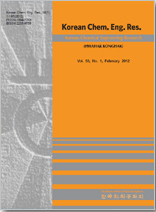Articles & Issues
- Language
- korean
- Conflict of Interest
- In relation to this article, we declare that there is no conflict of interest.
- Publication history
-
Received July 12, 2010
Accepted November 15, 2010
Available online February 9, 2011
-
 This is an Open-Access article distributed under the terms of the Creative Commons Attribution Non-Commercial License (http://creativecommons.org/licenses/bync/3.0) which permits
unrestricted non-commercial use, distribution, and reproduction in any medium, provided the original work is properly cited.
This is an Open-Access article distributed under the terms of the Creative Commons Attribution Non-Commercial License (http://creativecommons.org/licenses/bync/3.0) which permits
unrestricted non-commercial use, distribution, and reproduction in any medium, provided the original work is properly cited.
Copyright © KIChE. All rights reserved.
All issues
수직 배관 내의 농도변화에 따른 분진폭발 특성
Characteristics of Flames Propagating Through Combustible Particles Concentration in a Vertical Duct
한국산업안전보건공단 산업안전보건연구원 화학물질안전보건센터, 305-380 대전시 유성구 문지동 104-8
Chemical Hazard Research Team, Center for Chemical Safety and Health, Occupational Safety & Health Research Institute (KOSHA), 104-8 Munji-dong, Yuseong-gu, Daejeon 305-380, Korea
hanpaule@kosha.net
Korean Chemical Engineering Research, February 2011, 49(1), 41-46(6)
https://doi.org/NONE
https://doi.org/NONE
 Download PDF
Download PDF
Abstract
본 연구에서는 수직 배관 내에서 석송자 농도 변화에 따른 분진화염전파 특성을 상세히 조사하였다. 이를 위해 디지털비디오카메라와 PIV(Particle Image Velocimetry)를 사용하여 높이 120 cm, 단면 12 cm의 정방형 수직 덕트 내를 전파하는 분진화염의 입자거동을 해석하였다. 그 결과, 배관 내에 동일 평균농도의 분진운이 존재하는 경우 상방전파보다 하방 전파에 의한 화염전파속도가 크며 농도 약 300 g/m3까지의 경우에는 분진농도가 증가할수록 그 비율이 증가하였다. 후방 화염(Post flame)은 배관 측벽과 화염면 사이를 통과하여 전파화염 후방에 유입된 미연소 입자의 발화에 의한 것으로 배관의 밀폐조건과 관계없이 발생하였다. 또한 후방 화염의 발생 빈도는 농도의 증가와 함께 증가하는 것을 알았다.
We investigated experimentally the properties of dust explosion through lycopodium particle clouds in a duct to provide the fundamental knowledge. Propagating dust flames in the vertical duct of 120 cm height and 12 cm square cross-section were observed by digital video camera and flame front is visualized using by PIV(Particle Image Velocimetry) system. As the result, when the same average dust concentration existed in the vertical duct, downward flame propagation was faster than the upward flame propagation, its rate increased with dust concentration in 300g/m3. Post flames were caused by the ignition of unburned particles which flowed into the rear region of flame from passage between flame and duct wall, and they generated regardless of duct condition. Also, it was found that appearance frequency of post flames during dust flame propagations increased with the increase of dust concentration.
References
Eckhoff RK, Dust explosions in the Process Industries-3rd ed., Gulf Professional Publishing (2003)
Van der P, Wel, Ignition and Propagation of Dust Explosions, Delft Univ. Press, Netherlands (1993)
Mason WE, Wilson MJG, Combus. Flame, 11, 195 (1967)
Proust C, Veyssiere B, AIAA Progress in Astronautics and Aeronautics Series (1987)
Proust C, Veyssiere B, Combustion Science and Technology, 62, 149 (1988)
Veyssiere B, Powder Technology, 71, 171 (1992)
Ulrich K, Thomas K, Bela G, Bergen, Norway, 5.1-5.14 (1996)
Han OS, Yashima M, Matsuda T, Matsui H, Miyake A, Ogawa T, J. Loss Prev. in the Process Ind., 13(6), 449-457 (2000)
Han OS, Korean Chem. Eng. Res., 47(5), 572 (2009)
Han OS, Han IS, Choi YR, Korean Chem. Eng. Res., 47(6), 705 (2009)
Kean RD, Adrian RJ, Theory of Cross-correlation Analysis of PIV Images in Flow Visualization and Image Analysis, ed. F. T. M. Nieuwstadt, 1-25 (1993)
Adrian RJ, Annual Review of Fluid Mechanics, 23, 261 (1991)
ASTM E1226-88, Standard Test Method for Pressure and Rate of Pressure Rise for Combustible Dusts (1988)
Lewis B, Von Elbe G, Combustion Flames and Explosions of Gases, 2nd Edition, Academic Press Inc., New York, 292-294 (1961)
Van der P, Wel, Ignition and Propagation of Dust Explosions, Delft Univ. Press, Netherlands (1993)
Mason WE, Wilson MJG, Combus. Flame, 11, 195 (1967)
Proust C, Veyssiere B, AIAA Progress in Astronautics and Aeronautics Series (1987)
Proust C, Veyssiere B, Combustion Science and Technology, 62, 149 (1988)
Veyssiere B, Powder Technology, 71, 171 (1992)
Ulrich K, Thomas K, Bela G, Bergen, Norway, 5.1-5.14 (1996)
Han OS, Yashima M, Matsuda T, Matsui H, Miyake A, Ogawa T, J. Loss Prev. in the Process Ind., 13(6), 449-457 (2000)
Han OS, Korean Chem. Eng. Res., 47(5), 572 (2009)
Han OS, Han IS, Choi YR, Korean Chem. Eng. Res., 47(6), 705 (2009)
Kean RD, Adrian RJ, Theory of Cross-correlation Analysis of PIV Images in Flow Visualization and Image Analysis, ed. F. T. M. Nieuwstadt, 1-25 (1993)
Adrian RJ, Annual Review of Fluid Mechanics, 23, 261 (1991)
ASTM E1226-88, Standard Test Method for Pressure and Rate of Pressure Rise for Combustible Dusts (1988)
Lewis B, Von Elbe G, Combustion Flames and Explosions of Gases, 2nd Edition, Academic Press Inc., New York, 292-294 (1961)

